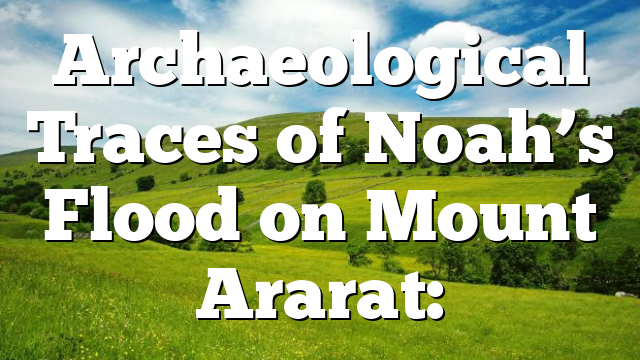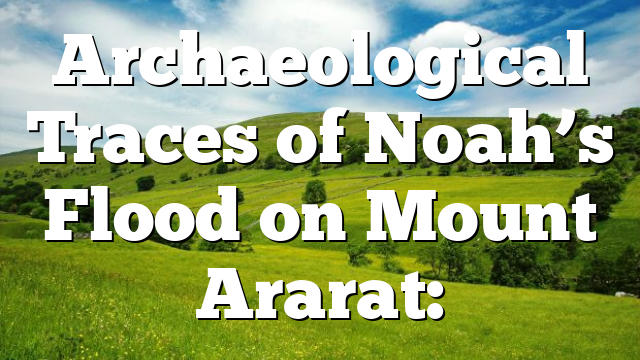Click to join the conversation with over 500,000 Pentecostal believers and scholars
Click to get our FREE MOBILE APP and stay connected
| PentecostalTheology.com




Archaeological Traces of Noah’s Flood on Mount Ararat:
Ancient Light from this Mountain
Philip Ernest Williams
Copyright 2022 by Philip Ernest Williams
Revision 2, August 2022
To the late Dr. Norman Geisler (1932-2019)
who so eagerly desired that I complete this book
concerning the only view of origins that
he ever endorsed with his name and scholarship
Preface
The author wrote this monograph for the International Conference on the Archaeological Traces of Noah’s Flood on Mount Ararat which took place May 5-7, 2022 near the town of Dogubayazit, Turkey. This symposium was held at Noah’s Village located on the road that traverses the south side of Agri Dagh, a mountain that is better known in most of the world as Mount Ararat.
This symposium of more than fifty archaeologists and other scientists and scholars from Turkey, Europe, the United States, and various nations of the region together with officials from the Governments of the Republic of Turkey and provinces near this mountain was sponsored by Andrews University of Berrien Springs, Michigan and by the North Carolina-based Mount Ararat Discovery Foundation. The latter is a 501(c)3 non-profit devoted to the preservation and authentication of artifacts found in the region of Mount Ararat and to the publication of scientific studies pertaining to these artifacts in peer-reviewed journals, all in cooperation with the Governments of the Republic of Turkey and its provinces and with the natives of this mountain and region. The conference was hosted by the Dogubayazit Faith Tourism, Development, and Research Association chaired by Ahmet Ertugrul.
This monograph, a summary of the author’s more than thirty years of extensive research, was written to assist the archaeological investigation of artifacts and what are reported to be an ancient wooden structure buried near the top of this mountain which the natives have always believed to be Noah’s Ark. The author serves as Scientific Advisor to the Mount Ararat Discovery Foundation.
References to so much scientific history that is hardly mentioned in popular scientific writings, and which differs from popular scientific histories may challenge many readers due to the vast amount of information summarized in this short treatise. Even so, I trust the reader will benefit from learning just how and why our current science came to understand the things that we are taught about the history of ancient man and the recent history of the earth.
Likely, the reader will be astonished to learn the strange and interesting way that the current historical sciences came about, but no less astonished by how simply the same evidence appears in the light of the narrative found in our sacred scriptures. The reader will understand why the late Dr. Norm Geisler believed the discoveries on this famous mountain understood in the light of the new understanding presented in this book could change our world.
Philip Ernest Williams (Charlotte, NC)
Chapter 1: Introduction
Many are familiar with the numerous reports of the remains of Noah’s Ark still resting on the top of this mountain by which we are gathered. Some of these reports date from before the time of Jesus. Josephus, the first century Jewish historian, writes that Berossus the Chaldean (3rd century BC) tells us that the Ark ‘was preserved when it was brought to the highest part of the mountains of Armenia,’ as this region was known in the first century.[1] That would require the Ark to have rested near the top of this mountain which we may be able to view later today as the covering clouds lift from the mountain.
I have however never been interested in searching for Noah’s Ark. Nor was I much interested in the many claims for the discovery of the Ark which I formerly supposed could not have survived for thousands of years. That was before I learned that organic remains could survive for so long if they have been constantly frozen as is the case of 5,000-year old Otzi the Iceman who was found under a glacier in the Alps back in the nineties. But my interest in these reports, ancient and modern, was because I had traced a secondary worldwide dispersion of mankind from the Ancient Near East which begins near this mountain. I was interested in knowing whether there are artifacts in the ancient wooden structure reported to be on this mountain that might be related to those of the widespread dispersion from near this mountain that archaeologists identified many years ago (see map below).[2]
The map above shows only the migration arm which spreads into the southern Levant. I will say more about the wider dispersion below. But should the wooden structure reported to be buried near the top of this mountain be the source of the archaeological culture spreading from this mountain, it will point to this region as the ancient homeland of the people of every nation who scattered across the earth carrying with them memories of a great world-destroying Flood.
I am grateful that the Government of Turkey is at last able to allow archaeological excavations on this frontier mountain which for many centuries has been the center of much trouble and danger. This mountain and region may soon become the center of worldwide scientific and historical investigations, helping bring peace to the nations and much attention to this region as the world discovers the land near where we are meeting is the ancestral homeland of us all.
The reason for my presentation today concerns the archaeological identification of artifacts that may be found inside the ancient wooden structure. Should they connect to the archaeological culture that spreads from this region (see map at left), the structure belongs to what archaeologists currently understand as the prehistoric era. It will date to the Chalcolithic Age when both copper and stone tools were being used. That is a millennium earlier than Archbishop James Ussher’s famous 2349BC dating of the Flood. I believe the error lies not so much with Ussher but with the current prehistoric chronology. Whatever the case, we may have in this project the means of determining just where the dating error does lie.
Determining this requires learning the strange reasoning behind the establishment of archaeology’s prehistoric chronology, the full story of which no historian of ideas has previously researched and published. Thus, it was necessary that I investigate just how archaeologists came to understand and date man’s prehistory. Here I will summarize the story of how a few thousand years of mankind’s earliest history got transformed into a few hundred thousands of years, leading to the dating problem that I just mentioned. It is also how the light of the sacred scriptures got replaced with speculative theories based entirely on naturalistic causes.
A paradigm shift for the historical sciences
I am sympathetic to how shocking this must seem to those who are well-trained in the historical sciences. It is foolishness because contrary to well-known facts. I could hardly expect my fellow scientists to be interested were it not for reports of an ancient wooden structure resting exactly at the one tiny spot on our large earth’s surface that suits the landing place of Noah’s Ark as told in the sacred scriptures. It must necessarily have rested near the top of the tallest(!) of the mountains of Ararat if the tops of the surrounding mountains weren’t visible when the Ark came to rest.[3]
Alfred North Whitehead, who as President of the Royal Society defended Einstein’s new theory of relativity, reminds us that there are no uninterpreted facts. All observations must be interpreted according to some theory or narrative. Nowadays, such a light is called a paradigm. Thomas Kuhn, the philosopher of science who popularized the concept of paradigm, explains the difference between normal and revolutionary science. So implicit is our trust in what we are taught to believe that during times of normal science a contrary paradigm will seem foolish.
The paradigm that we so implicitly trust that we may not even be conscious of using is the light by which we ordinarily see and judge things. Because such understandings are believed a priori, they cannot be used to judge a different paradigm for understanding evidence. There is however a way of judging between paradigms. Another philosopher of science Karl Popper pointed out that good paradigms make specific and therefore testable predictions.
For example, in the light of the evolutionary paradigm, we should have found the still missing links between species. In the light of young earth Creation Science, there should be massive evidence of civilizations drowned by the worldwide Flood in the third millennium before Christ. Unfortunately, the failure to find such evidence can either be ignored or else explained away by ad hoc theories. Evolutionists tell us that not even one of the many evolutionary links that must exist between species was preserved in the fossil record. Similarly, the Creationists tell us that the Flood itself wiped away all the evidence of the many people together with their dwellings and cities who lived before or who died in the Flood.
Though I will put forth here manifest evidence of a worldwide Flood and the recent appearance of man, I am not a young earth Creationist. Many young earth Creationists are troubled by reports of the remains of Noah’s Ark being found on this mountain which sits atop of what they tell us is the geological evidence of the Flood. They believe this mountain must be a post-Flood volcano which didn’t exist when the Ark rested on the mountains of Ararat. Some young earth Creationists have a different view, but my old earth science is so different from Creation Science that I coined for it the term Scripture Science. Scripture Science differs from both mainstream science and Creation Science in that its light is neither a scientific nor a theological system but a simple historical narrative.
Whatever one must or chooses to believe, some type of paradigm is unavoidable due to it being the light by which we turn observations into what we understand to be the facts. To judge paradigms, whether it be the uniform laws of the current historical sciences, the young earth view of the Creationists, or the one I use here we need first understand the circumstances that led to their establishment. Then we should compare what we see in the light of these various paradigms. Just as focusing the Hubble telescope’s lens gave a clearer picture of the beginnings of our physical universe, replacing the paradigm of the current historical sciences with a true one ought to give a clearer and simpler understanding of mankind’s most ancient history. It should allow us to predict many things that we now understand as isolated facts.
The paradigm I will use here however is not a new light but an old lamp which our modern world has discarded due to it being seen as too ancient. But having used it to understand the evidence of the current historical sciences, I found it a powerful light for simplifying and clarifying our understanding of origins.
[1] Josephus, Whiston translation, Against Alpion, Book I, Chapter 19, passage 130
[2] Map and migration path from Ammon Ben-Tor, The Archaeology of Ancient Israel, (Yale University Press, 1994), p 123. Text at left is from this author.
[3] c.f. Genesis 8:5


